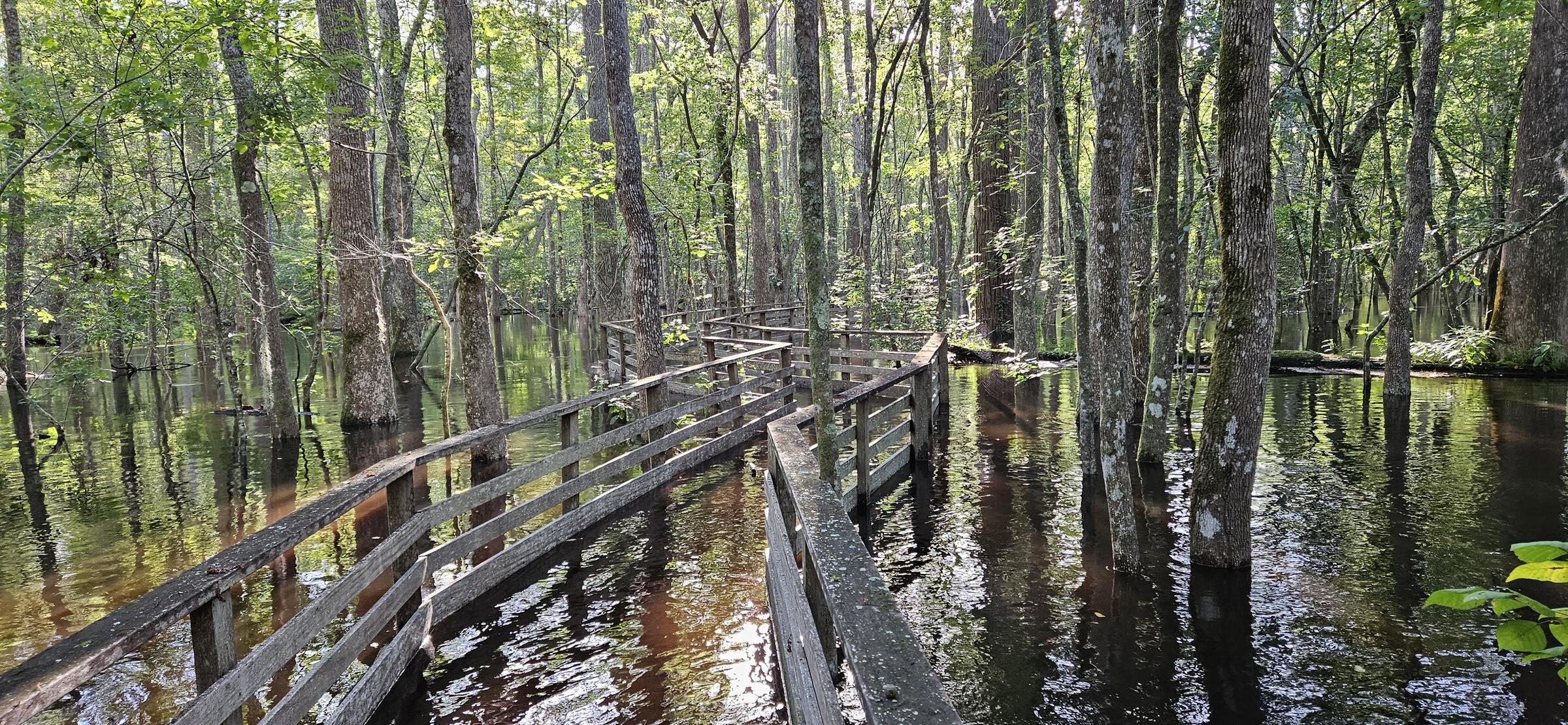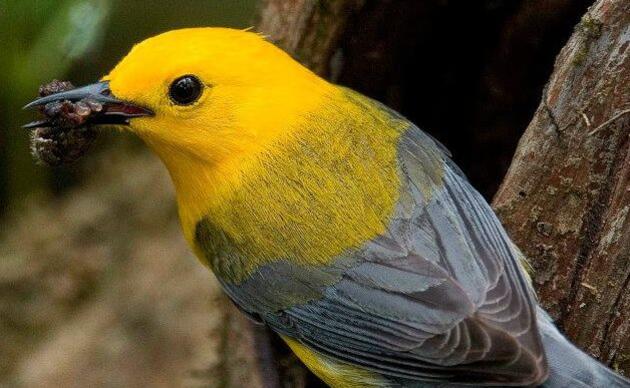In the history of the boardwalk (since 1977) there are only a handful of years in which the water actually got high enough to submerge it. The first was in 1979 with Hurricane David, where the water got up to 9.92 feet. That was the record until 2015, when South Carolina experienced the “1000 year flood” where the water rose to 10.27 feet. Then again in 2016 the water rose to 9.40 feet (and which I like to refer to as the “500 year flood”). And just recently the boardwalk flooded again on Saturday the 2nd of September, 2023, where the water came up to 8.5 feet due to the effects of Tropical Storm Idalia. To give you some sense of scale that puts most of the boardwalk under a few inches of water.
The flooding event on the 2nd was a surprise for all of us, maybe not so much the height that it rose to but how quickly it rose. The storm passed Wednesday, we checked the boardwalk Thursday and everything seemed fine, the water level was recorded at 5.4 feet by the end of the day. We assumed the rest of the weekend would be business as usual. But by noon on Friday the water had shot up to 7.69 feet and was beginning to seep up between the deck planks. By this time nearly all of the cypress knees were underwater, and the dwarf palmettos fronds were poking up out of the water like green fingers grasping for air.
A guest had alerted to us that a Cottonmouth was on the boardwalk, and while by now it’s a daily occurrence for a Brown Water Snake or Greenish Rat Snake to be using the boardwalk to sunbathe, in my eleven or so years here I’ve only seen venomous snakes on the boardwalk 4 times, most of them within the last few years. Since there were still other guests out on the walk my colleagues and I decided that the safe and responsible thing to do was to remove the snake (gently) from the boardwalk. I felt sympathy for the Cottonmouth, it was clearly concerned about the fast flow of the water and knew the boardwalk was safe. I’m confident it found another place to rest, if you’ve been on our canoe trail you know it’s pretty easy to catch on everything the moment you let the current push you downstream.
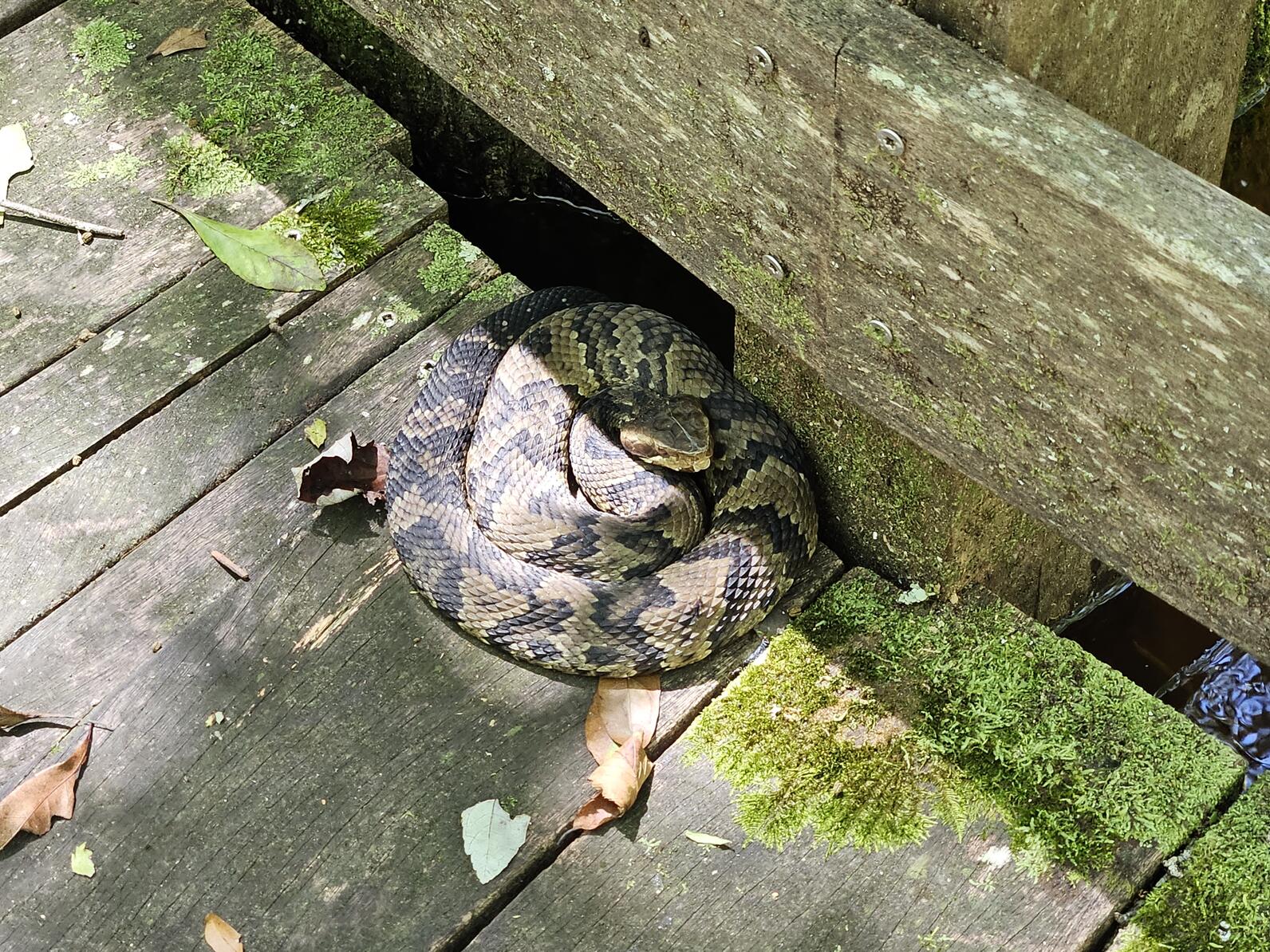
And it wasn’t just the snakes that were trying to avoid the fast moving water. When the water gets high the current increases dramatically, more energy pushing it all downstream. I saw a Spotted Turtle that wasn’t even able to swim in place against the current. Bronze Frogs had climbed up onto the boardwalk because they didn’t want to deal with it, either. Beetles and other invertebrates were beginning to wander out onto the open deck, their homes underwater. Even a Mole Salamander had crawled up through the deck boards to get away from the flood. Hooded Warblers and Louisiana Waterthrushes were out in the open patrolling the handrails, easy pickings with all the exposed insects.
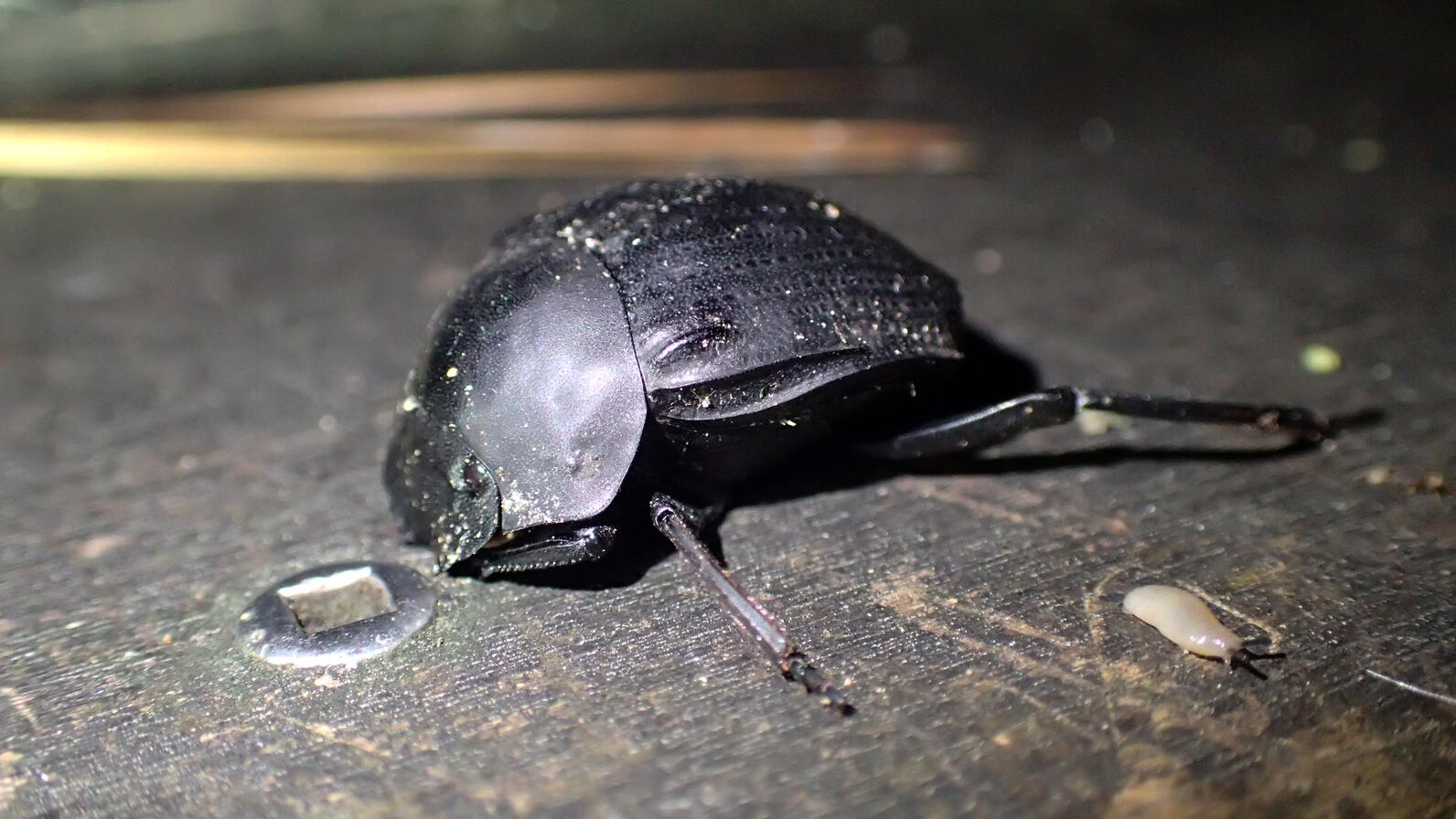
This now left us unsure about Saturday and Sunday. How high was the water going to rise? We were prepared to go on regular venomous snake patrols but by Saturday morning most of the boardwalk was under a few inches of water, so we decided that it was just easier to close off the boardwalk for the day. By 5PM the water had risen up to 8.5 feet and seemed to be slowing down.
As the sun set I knew I had an opportunity on my hands, one that might not happen again in a while. I donned some water boots and waded out onto the boardwalk, seeking to be there as the moon rose. The floating piles of built up debris glittered like stars, hundreds of prismatic eyes reflecting in my headlamp as spiders clung to the only refuge they could find. A full representation of local invertebrates were on the handrail, arachnids, insects, mollusks, and myriapods (millipedes and centipedes) moved down the handrails like they were highways (sort of like on I-95 during rush hour near Savannah).
Also running along the handrails was a flabbergasted White-footed Mouse, its entire world underwater, and two opportunistic raccoons who kept their distance. As I was leaving I decided to check the back part of the boardwalk and was rewarded with three River Otters, barking and chirping quietly to each other in concern. They cannot see well at night and couldn’t tell what I was. I kept my distance and let them argue among themselves until they finally decided to slide off into the water, continuing to call out to each other to stay close.
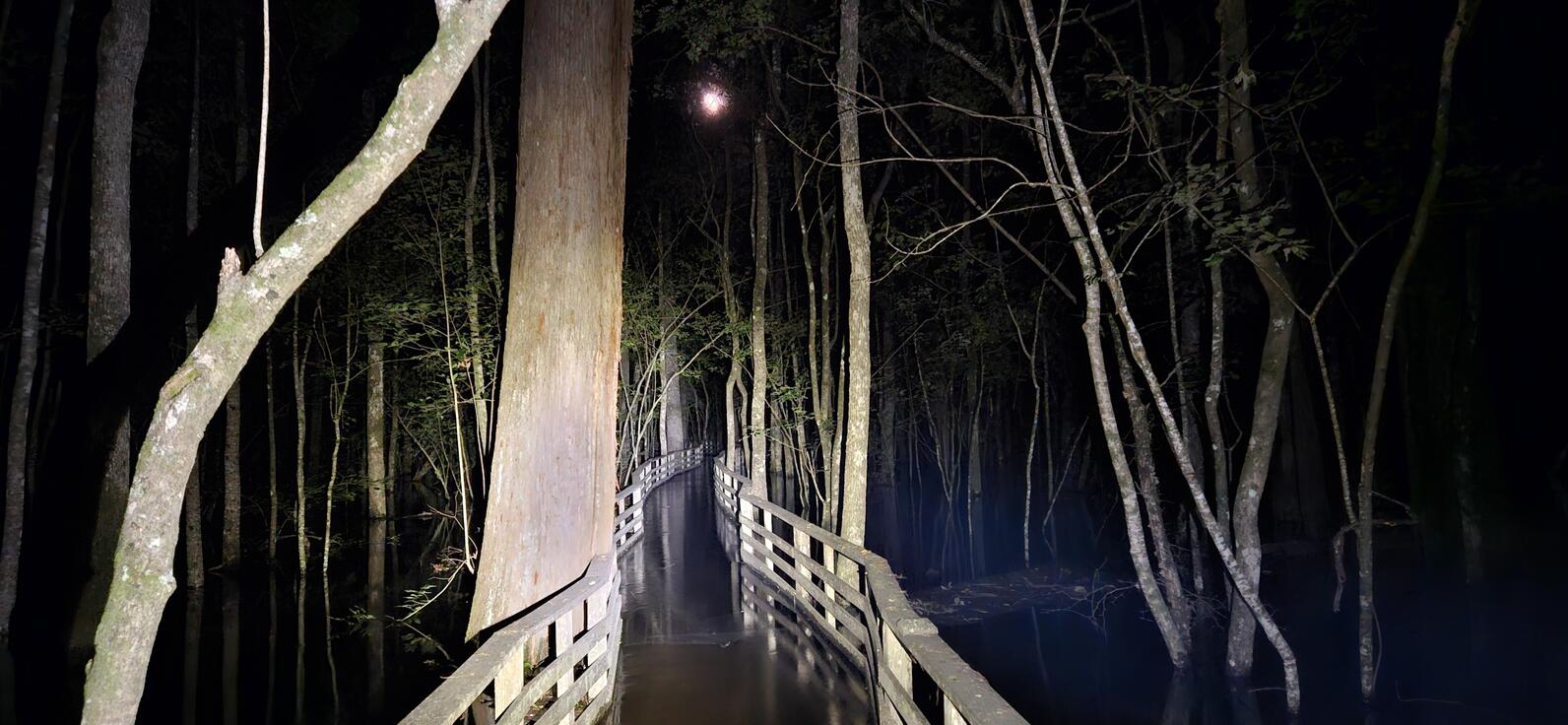
For Sunday the water was lower but parts were still submerged so we decided to forgo with admission and just rope off most of the boardwalk. By closing time on Sunday the water had receded from the boardwalk entirely.
So what made the water rise so fast? I looked online for rainfall data from points in our watershed, starting at Orangeburg, which received 5 to 8 inches of rain from the storm Wednesday. Despite the distance Orangeburg is in the Four Holes Swamp watershed, so if it gets rained on we will see a rise of water around the boardwalk eventually. Yet the flooding seemed too sudden for that distance. I then looked at rainfall for Holly Hill, which received 13.55 inches of rainfall! That’s probably the reason why the swamp went from business as usual on Thursday to Waterworld on Saturday.
By the next weekend the water was relatively back to normal, and all of the animals have sorted themselves out by now. What’s even more interesting is while our water level crested at approximately 10PM on the 2nd, the Edisto River at Givhans Ferry crested at 7AM on the 4th, which meant Holly Hill’s influx was delayed by a day and a half by the swamp, which is exactly what you want a wetland to do!
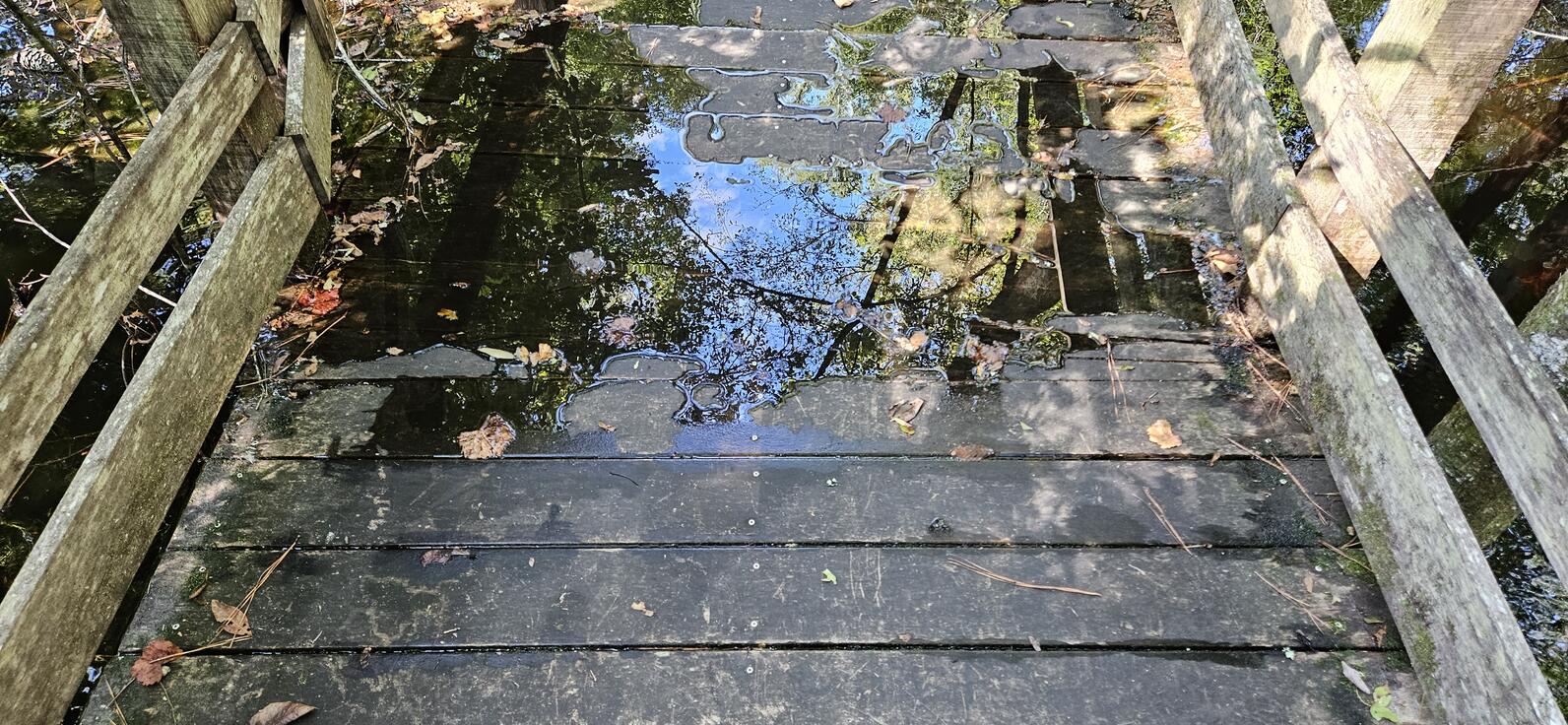
This episode reminded me about how connected we all are, how what impacts Orangeburg or Holly Hill or Cameron will eventually affect us, whether we know it’s coming or not. In turn everything downstream from us along the Edisto River are affected by what happens in the swamp. A lot of people try to make the “not in my backyard” argument, but I always feel this is shortsighted, it’s an attempt to unrealistically separate yourself from your connections. The boundary defined as “backyard” is a human-only distinction and not recognized by anything else, not by wildlife, not by invasive species, not by floods nor pollution.
It’s important to remember the connections we have not just to nature and the landscape but to our neighbors as well, because the things we do don’t just stay within our fences or cease to exist because they’ve drifted out of sight. The dust from the Sahara reaches us as does the smoke from western forest fires, and there’s trash on both Everest and down in the Mariana Trench. The water that flowed around my boots during the flood may as well be in the ocean by now.

